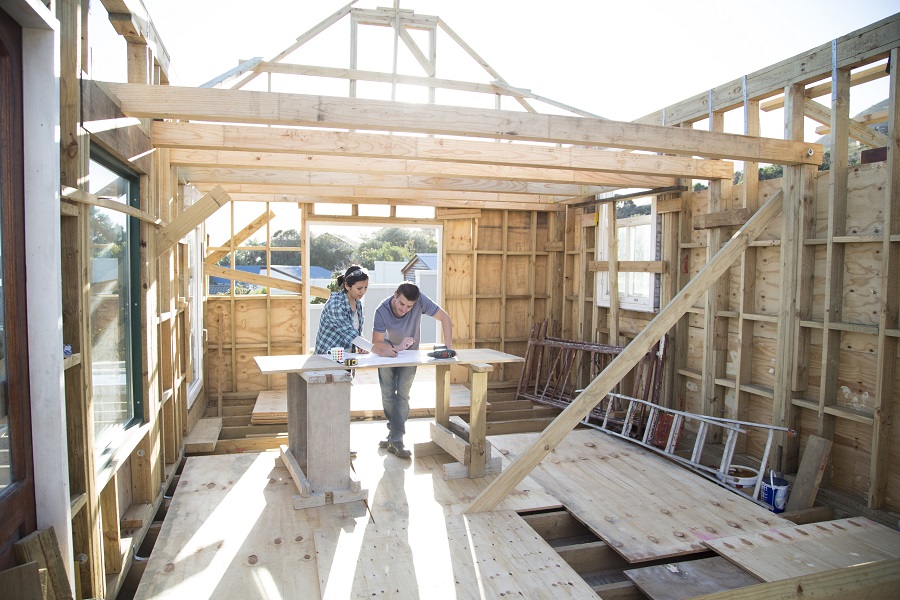- Fewer single-family homes are being built. Those that are have less square footage and stand on smaller lots.
- This pattern is consistent across all nine census divisions, except for the West South Central division, where the median lot size has grown.
- Homes with three or more stories now make up 5 percent of all new single-family home construction.
One factor in the continuing escalation of home values is that there are fewer new single-family homes.
The square footage of the typical new home decreased slightly in 2017 from 2016 – to 2,300 square feet from 2,400 square feet – continuing a gradual decline that has lasted for much of this decade, according to a Zillow analysis of U.S. Census Bureau Survey of Construction data. The size of the typical lot on which these new homes stand also shrank from the previous year, following a similar trend.
This pattern is consistent across the country. In each of the nine census divisions, the size of the median single-family home either decreased in size or remained approximately the same (within 100 square feet of last year) when compared with 2016. The same can be said for lot size, except in the West South Central division (Arkansas, Louisiana, Oklahoma, and Texas) where the median lot size increased by 750 square feet.
Which regions led the slowdown?
Fewer homes were built across the country in 2017 than in 2016. The decline was led by the South Atlantic division (Delaware, Florida, Georgia, Maryland, North Carolina, South Carolina, Virginia, Washington, D.C. and West Virginia), which saw a double-digit percentage point decrease in new construction. That region is the most populous of the nine divisions and, despite the drop, continues to lead the country in new home starts, as it has for the last several years.
In December 2017, more than 30 percent of the new homes built throughout the country went up in the South Atlantic, a region whose share of new homes has gradually risen over the last three years. Its large share of new homes is due mostly to there being less construction nationwide.
Nearly 90,000 fewer homes began construction in the South Atlantic in 2017 than in 2016, a decrease of nearly a quarter. Amazingly, in percentage terms, the decline in the South Atlantic was the smallest across the country. Fewer homes were built in each of the nine census divisions in 2017 compared to 2016. The largest percentage decrease was in the East South Central division – the second smallest division in terms of population with Mississippi, Alabama, Tennessee, and Kentucky – where more than 40 percent fewer homes began construction last year than the year prior.
As both home sizes and lot sizes have gradually fallen over the last few years, the ratio between them has remained consistent. In December 2017, the typical home/lot size ratio for new construction was just under 35 percent, consistent with the three-month moving average. Taking a slightly different approach, comparing the median home size to the median lot, the ratio is still right in line with the longer-term trend.
Looking at the division-level, however, these ratios have shown more variation, particularly in New England and in the Pacific. In December 2016, a new home in the Pacific division (Alaska, California, Hawaii, Oregon and Washington) took up more than half the size of the lot. That ratio decreased to 39 percent in December 2017. The Mid-Atlantic (Connecticut, New Jersey, New York, Pennsylvania) and New England divisions have experienced similar volatility, but the remaining regions have generally followed the national trend and seen slight decreases in home-to-lot-size ratios.
How tall is the typical new home?
One- and two-story homes have been the most commonly constructed single-family homes for years, a trend continued through 2017. However, as overall construction has declined, so has the relative share these home types.
Houses with three or more stories represent 5 percent of all new construction, but that rate has risen in recent years. In December 2014, three-story homes made up less than 1 percent of all new construction.
This trend deviates when geographic divisions are considered. In the Mid-Atlantic and New England, there are now approximately as many one-story as three-story homes being built. Both divisions have experienced a gradual decline in two-story construction and a steady increase in the other two types. Despite these shifts, two-story home construction continues to comprise most new home construction in these areas; in New England, they represent more than three-quarters of all new construction.
How fast are detached versus attached homes being built?
Across the country, construction of detached single-family homes has been decreasing at about the same rate as that of attached single-family homes. By the end of 2017, attached homes – also known as townhomes or condos — made up just under 13 percent of all new construction, about the same portion as they did at the end of previous years.
Regionally, the portion of new homes that are attached increased in the Mid-Atlantic and the East South Central divisions, although that rise has largely been driven by an overall decrease in the construction of detached homes.
Detached homes still make up a large majority of new construction – more nearly 90 percent by the end of 2017 – and more than 95 percent of those homes are either one or two stories. Attached homes, however, have a much more even distribution of stories. Construction of both one- and three-story townhomes has increased in overall share over the last few years. Three-story homes have experienced a substantial rise: They now make up more than 28 percent of all construction of new attached homes. They were less than two percent just three years prior.
